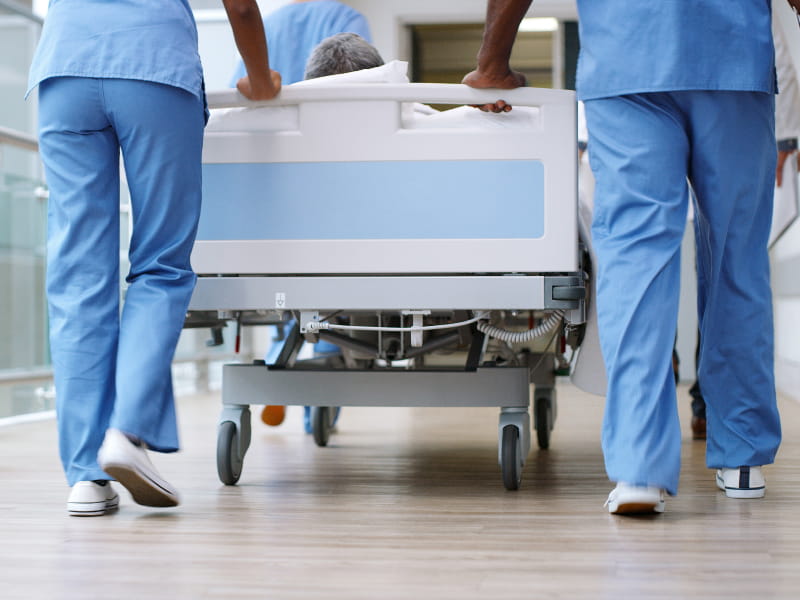Is it safe to go to the hospital during COVID-19 pandemic? Doctors say yes
By American Heart Association News

When concerns about catching the coronavirus encourage people to stay physically distant, that's healthy. When those fears drive ailing people away from hospitals, though, it could be dangerous.
To such people, doctors say: Your emergency room is safe. And if you need to go, you should.
Hospitals are updating safety procedures in lots of ways, said Dr. Patricia Best, an interventional cardiologist. She is an associate professor of internal medicine and cardiovascular diseases at Mayo Clinic College of Medicine and Science in Rochester, Minnesota.
"With this pandemic likely to go on for months, if not a year or longer, we need to make sure people are getting timely care for all of the things that they need," she said. And that means if someone is "having something that on any other day, they would be calling an ambulance, they should call an ambulance."
Not everyone is. An April study in the Journal of the American College of Cardiology(link opens in new window) said admissions for a serious type of heart attack known as STEMI(link opens in new window) dropped 38% after March 1, after the pandemic hit. In news reports, people have specifically cited coronavirus worries as the reason for avoiding hospitals.
Dr. Phillip L. Coule, vice president and chief medical officer at the Augusta University Health System in Georgia, said admissions in his hospital were down by 25% to 40%.
"Some of that appears to be driven out of fear," he said. "Certainly, some of it is driven out of canceling elective cases, delaying procedures and things like that. But I'm quite certain that there is a component that is driven out of people not seeking health care because they're concerned about the potential of becoming infected with COVID-19."
That's a bad idea, he said. "The risks posed by ignoring heart attack and strokes are far greater than the risks posed by COVID-19 and seeking health care."
That holds true even in cities where the virus has hit hard, said Dr. Alice Jacobs, professor of medicine at Boston University School of Medicine. She's vice chair for clinical affairs in the department of medicine at Boston Medical Center and a past volunteer president of the American Heart Association.
Fast care is the key to survival, she said. "The relationship between opening the blocked artery causing the heart attack and the chance of dying is measured in minutes." And hospital workers need extra time now to allow for coronavirus safety measures.
But Jacobs, lead author of new guidance for STEMI care during the pandemic(link opens in new window) released Saturday by the AHA, said the entire emergency care process is adapting, starting in ambulances, which are being decontaminated and restocked with COVID-19 in mind.
At Coule's facility, patients with COVID-19 symptoms are being diverted at the emergency room entrance to a separate area so they don't mix with patients who have non-COVID-19 issues.
At Mayo Clinic, Best's catheterization lab – the part of the hospital that evaluates and treats heart patients – also has made changes. Some might be obvious. Patients are being met by workers in full protective gear, and family member access is restricted.
Other changes are technical. The temporary STEMI guidance, which Best co-wrote, suggests more intense cleaning procedures and cutting back on the number of workers exposed to potentially infected patients. Other experts have issued temporary guidance(link opens in new window) from the AHA to help protect stroke patients.
Away from hospitals, new safety measures at a family physician or urgent care clinic might vary, she said. But for a true emergency, people need to call 911 and be taken to an emergency room no matter what.
Concerns about people not heeding such advice led the leaders of eight health organizations, including the American College of Cardiology, Heart Rhythm Society and AHA, to issue a statement(link opens in new window) in April that said, "Calling 911 immediately is still your best chance of surviving or saving a life."
Coule agreed.
"I'm a huge fan and proponent of using urgent cares and telemedicine and private physicians when appropriate," he said. "But if you're having … symptoms of heart attack or stroke, those are not viable solutions. Those are patients who need to be seen in an emergency department that's qualified and capable of taking care of them. That's true on any day, and that's true during COVID-19."
Coule follows his own advice.
"I actually had chest pain during this crisis," he said. He was at work at the time and, as many people do, he pondered for a moment as to whether he really needed to go.
But not for long. He reported to the emergency department and got a cardiac evaluation, "and everything turned out great." He was sent home at midnight and was back at work the next morning.
Fear of getting COVID-19 was never an issue. But he worries about a wave of people who have delayed care for all kinds of problems. It's crucial they don't, he said.
"I would tell my parents, who are both heart disease survivors, that if they needed a procedure, it's perfectly safe to come in and have that procedure done now," he said. "I wouldn't worry about their safety or the potential for catching COVID-19 in the hospital."
Editor's note: Because of the rapidly evolving events surrounding the coronavirus, the facts and advice presented in this story may have changed since publication. Visit Heart.org for the latest coverage, and check with the Centers for Disease Control and Prevention and local health officials for the most recent guidance.
If you have questions or comments about this story, please email [email protected].





